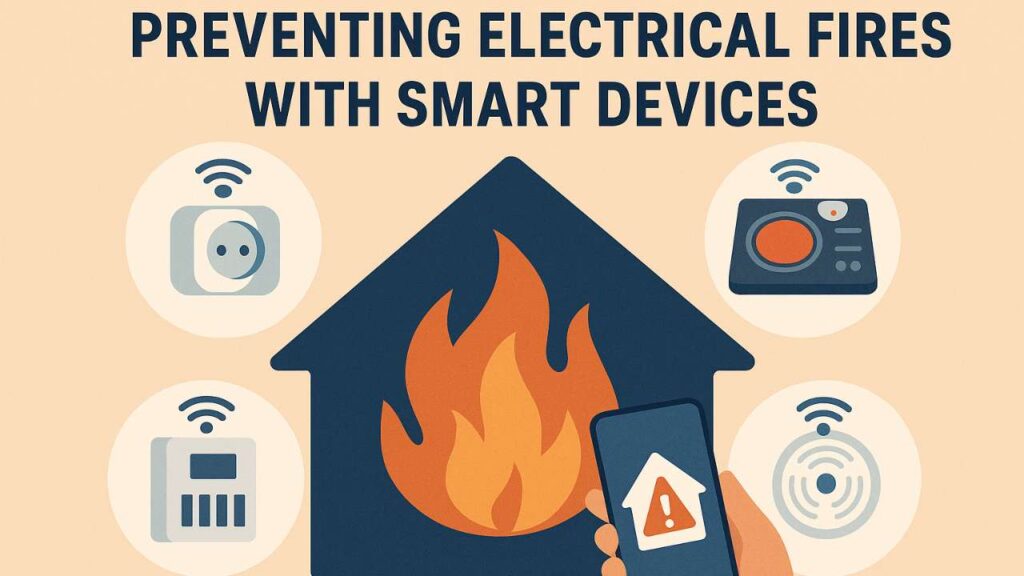Smart home technology is instrumental in promoting electrical fire safety, especially in the United States. Most American homes are stick-built and contain a rapidly growing number of power-hungry appliances and gadgets, making them highly prone to electrical fires.
Many smart devices can predict or prevent electrical fires from spreading. Adopting every shiny new product can be costly, but prioritizing the following innovations can help you safeguard your home from electrical fires.
Smart Electrical Network Monitors
A smart electrical network monitor is a plug-and-play device that collects and measures electromagnetic data from your home’s electrical system. It can sense and locate arcs and sparks when they occur to help you address them before they start a blaze.
This tech uses AI and machine learning to identify strange patterns associated with electrical fire hazards. It can sniff when something’s amiss with your home wiring, plugged-in appliances and gadgets, and connection to the grid.
This smart device can transmit data to your phone or tablet via Wi-Fi. You can check the information it gathers through its companion app, which informs you to contact a qualified professional to fix the matter and avoid a costly disaster.
Smart Stovetops
A smart stovetop minimizes the fire risk linked to unattended cooking. Motion and thermal sensors let this kitchen appliance know when the cook leaves the room and monitor its temperature and those of the surrounding areas.
More advanced models leverage AI and thermal imaging to analyze stovetop activity and predict perilous situations like overheating.
Smart stovetops use automation to suppress fires and keep you posted. They can shut off the heat, notify you with visual and audible warnings and extinguish the flames immediately with a fire-retarding agent.
Smart Plugs
A smart plug lets you remotely control a wired device connected to it through its companion app or other smart devices, such as smart speakers and hubs. This ability allows you to cut the power to appliances and gadgets when not in use from anywhere, which is just as effective as unplugging them from receptacles to reduce the risk of electric fires.
Some models can protect against overcurrent, surges and overheating. Others are programmable, letting you schedule when to turn specific devices on and off. Smart plugs can also monitor power consumption, alerting you about electric appliances and gadgets that uncharacteristically draw higher amounts of energy or are too hot.
Smart Heat Sensors
A smart heat sensor watches out for increasing temperatures, which typically indicate potential electrical issues. Some focus on overheating and sound the alarm when the thermal energy surpasses a preset threshold. Others are attuned to rapid rises in temperature in a space, detecting when your garage door opener’s motor short-circuits after a disruption to its power source or when your EV overburdens your circuit breaker while charging.
You can integrate smart heat sensors with the rest of your smart home system. Pairing them with smoke detectors isn’t overkill, for they’re less susceptible to false alarms. Cooking fumes and steam don’t trigger smart heat sensors. They’re perfect in areas where smoke detectors can be unreliable, such as the kitchen and bathrooms.
Smart Batteries
Smart batteries lend remote monitoring and automation functionalities to nonsmart devices. They can power your traditional smoke, heat, and carbon monoxide detectors and let you know when to install fresh ones without waiting for your safety devices to beep or chirp.
These Wi-Fi-enabled units can have audio sensors to know when your detectors sense a hazard, notifying you on your mobile device through their companion apps.
Preventing Electric Fires With Smart Devices
A smart home is a fire-resistant home. The bigger your network of smart devices, the greater protection against electrical fires you can enjoy. If you find adopting all of them overwhelming, start with the technology that suits your lifestyle best and build your system from there.


